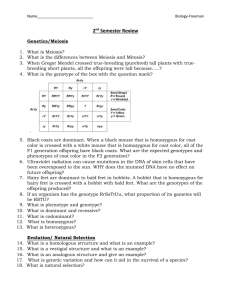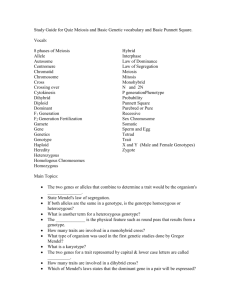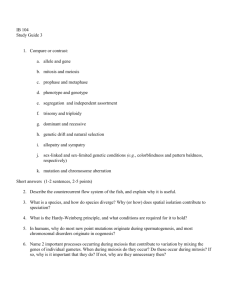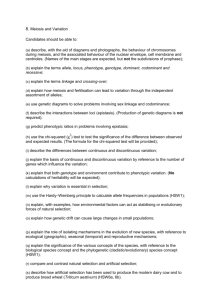Biology/Honors Biology Study Guide for 3rd Quarter
advertisement
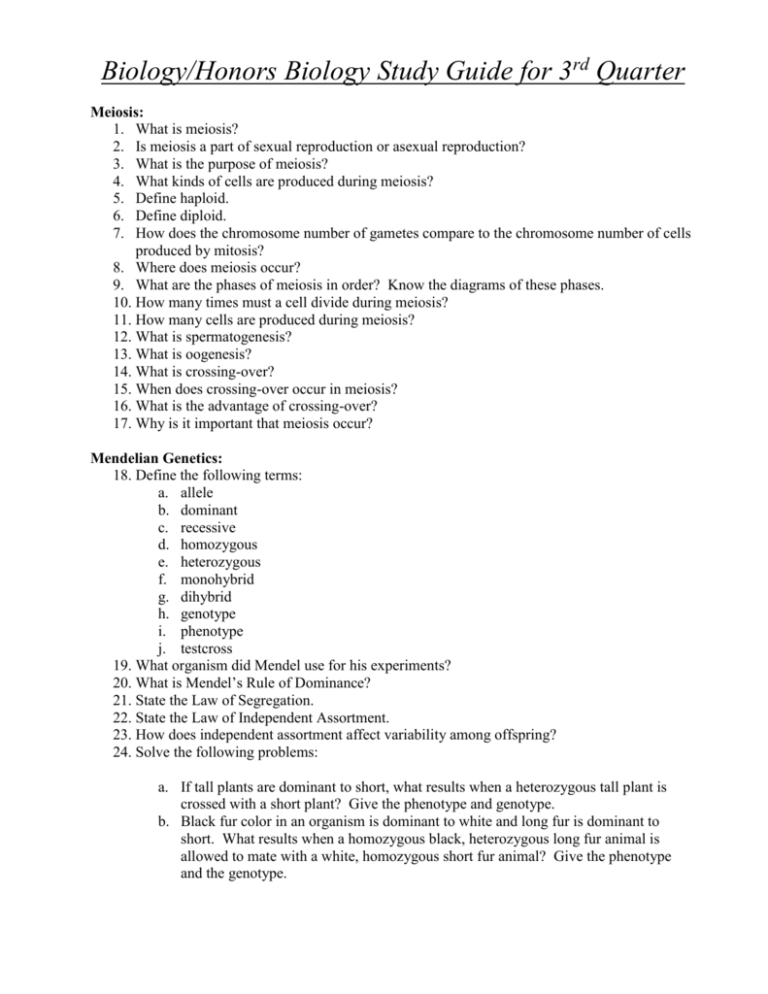
Biology/Honors Biology Study Guide for 3rd Quarter Meiosis: 1. What is meiosis? 2. Is meiosis a part of sexual reproduction or asexual reproduction? 3. What is the purpose of meiosis? 4. What kinds of cells are produced during meiosis? 5. Define haploid. 6. Define diploid. 7. How does the chromosome number of gametes compare to the chromosome number of cells produced by mitosis? 8. Where does meiosis occur? 9. What are the phases of meiosis in order? Know the diagrams of these phases. 10. How many times must a cell divide during meiosis? 11. How many cells are produced during meiosis? 12. What is spermatogenesis? 13. What is oogenesis? 14. What is crossing-over? 15. When does crossing-over occur in meiosis? 16. What is the advantage of crossing-over? 17. Why is it important that meiosis occur? Mendelian Genetics: 18. Define the following terms: a. allele b. dominant c. recessive d. homozygous e. heterozygous f. monohybrid g. dihybrid h. genotype i. phenotype j. testcross 19. What organism did Mendel use for his experiments? 20. What is Mendel’s Rule of Dominance? 21. State the Law of Segregation. 22. State the Law of Independent Assortment. 23. How does independent assortment affect variability among offspring? 24. Solve the following problems: a. If tall plants are dominant to short, what results when a heterozygous tall plant is crossed with a short plant? Give the phenotype and genotype. b. Black fur color in an organism is dominant to white and long fur is dominant to short. What results when a homozygous black, heterozygous long fur animal is allowed to mate with a white, homozygous short fur animal? Give the phenotype and the genotype. 25. What is the expected ratio of offspring in the F1 generation of a typical monohybrid cross (homo dom X homo rec)? 26. What is the expected ratio of offspring in the F2 generation of the cross above? 27. What is the expected ratio of offspring from a dihybrid cross involving 2 traits? 28. How does incomplete dominance differ from codominance? 29. Work the following problems: a. In 4 o’clock flowers, red flower color is incompletely dominant to white. What results when a red flower is crossed with a white flower? b. In chickens, black feathers (B) and white feathers (W) show codominance. Checkered chickens are represented as BW. If a black chicken is allowed to mate with a white chicken, what percent of their offspring will be black? Human Genetics: 30. Blood types are a type of inheritance known as ________________ alleles. 31. What are the blood types? 32. What is the genotype for a person with type O blood? 33. What are the possible genotypes for a person with type A blood? 34. What are the possible genotypes for a person with type AB blood? 35. Which alleles are dominant in blood types? 36. Which allele is recessive in blood types? 37. How is it possible for parents with 2 different blood types to have children expressing all 4 blood types? Work a problem to show this. 38. Cross a homozygous type A person with a type O person. What are the blood types of their offspring? 39. What type of inheritance controls traits like skin color, hair color and eye color? 40. When human population data is surveyed for a polygenic trait, what will the resulting graph look like? 41. What are the sex chromosomes for a human male and a human female? 42. List two sex-linked recessive disorders and the genotypes that produce those disorders. 43. Why are males more likely to have sex-linked traits? 44. Cross a male with hemophilia with a female that is carrier. What is the probability that they will have a child with hemophilia? 45. What is the diagram below called? __________________________ 46. What information do you know from the previous diagram? 47. What is the diagram below called? 48. What type of genetic disorder is most likely shown in the diagram above? 49. What is the relationship between individual I-1 and III-3? 50. What are the genotypes of the individuals in the diagram above? 51. What is Huntington’s Disease? Include the mode of inheritance, physical symptoms, and genotypes for a person with the disorder and a normal person. 52. What is Sickle Cell Anemia? Include the mode of inheritance, physical symptoms, and genotype for a person with the disorder, a carrier of the disorder and a normal person. 53. What is Cystic Fibrosis? Include the mode of inheritance, physical symptoms, and genotype for a person with the disorder, a carrier of the disorder and a normal person. 54. What is Down Syndrome? Include the cause of the disorder, the trisomy identification and physical symptoms of the disorder. 55. What is Turner Syndrome? Include the cause of the disorder, the genotype identification and physical symptoms of the disorder. 56. What is amniocentesis? 57. List a few other health issues that have a genetic link (other than the genetic disorders covered in class). Biotechnology: 58. What was the purpose of the Human Genome Project? 59. What is gel electrophoresis? 60. In gel electrophoresis, which fragments of DNA move most rapidly through the gel? 61. DNA has a negative charge. Where does it move during gel electrophoresis? 62. What is a DNA Fingerprint? 63. List two ways that DNA Fingerprinting is useful. 64. Based on the fingerprint below, who is the father? Mom Baby Dad A Dad B 65. What is gene therapy? 66. What is the function of a restriction enzyme in genetic engineering? 67. What are sticky ends? 68. What is recombinant DNA? 69. What is a transgenic organism? Give one example. 70. List 3 specific practical uses of genetic engineering. 71. What is cloning? Evolution: 72. What is a fossil? 73. How is the age of a fossil determined? 74. Describe the experiment of Redi and its purpose. 75. Describe the experiment of Spallanzani and its purpose. 76. Describe the experiment of Pasteur and its purpose. 77. What is the difference between spontaneous generation and biogenesis? 78. Describe the experiment of Miller and Urey and its purpose. Be sure you know that the apparatus looked like. 79. Describe the characteristics of the first life forms (according to evolutionary theory). 80. What is endosymbiosis? 81. What is biological evolution? 82. What is an adaptation? 83. Who was Charles Darwin? 84. What is natural selection? Give an example. 85. What does it mean for an organism to be “fit” for its environment? Material from 1st Semester Use previous study guides to review 1st semester material on ecology, cells, cellular transport, molecular genetics and cell division.


